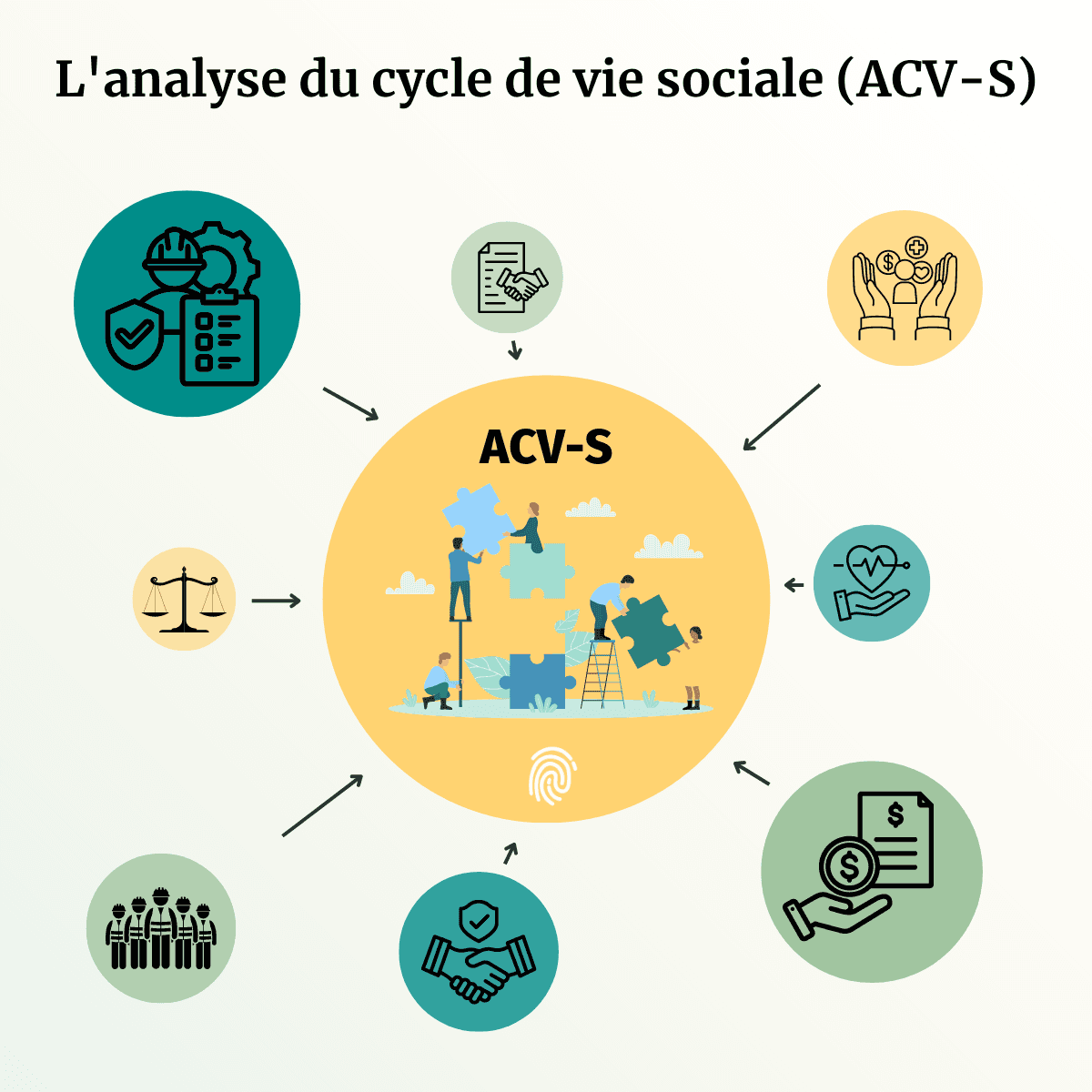Volcy Boilevin
L'analyse du cycle de vie sociale (ACV-S)
5 minutes
Nov 30, 2021
Key takeaways
3Ps - three-pillar approach of sustainable development: People, Planet, and Profit.
The three analytical tools to assess these pillars are: S-LCA (People), E-LCA (Planet), and LCCA (Profit).
The application of the three methodologies to assess sustainability performance leads to a Life Cycle Sustainability Assessment (LCSA).
According to the Organisation for Economic Cooperation and Development (OECD), "Due diligence" is the process through which organizations identify, consider, and address the potential environmental and social impacts and risks relating to concerned activities as an integral part of their decision-making and risk management systems.
The seventeen Sustainable Development Goals (SDGs) and their 169 targets have been internationally accepted by governments, industries and organizations and now represent the main reference for efforts geared towards sustainable development. Fourteen of the seventeen goals concern social impacts, most of which have obvious connections with the S-LCA framework.
Social Life Cycle Assessment (S-LCA) is a methodology to assess the social impacts of products and services across their life cycle.
S-LCA can either be applied on its own or in combination with Environmental Life Cycle Assessment (E-LCA) and/or Life Cycle Costing (LCCA).
What is a S-LCA?
Sapiologie is a member of the Life Cycle Initiative, hosted by the United Nations Environment Programme (UNEP), which provides resources, training, and guidelines for LCAs. The following S-LCA description and methodology are from the latest UNEP guidelines of 2020.
1. Objectives of a S-LCA
Overall:
Support EU policies and strategies to enhance human well-being and social justice.
Provide increased knowledge on the three-pillar approach of sustainable development.
Offer an assessment method for Human Rights Due Diligence.
S-LCA, performed together with E-LCA, helps understand the intersection of social and environmental issues, by better aligning environmental sustainability efforts with social efforts.
Specific:
Assess the positive and negative social and socio-economic impacts of products over their lifecycle.
Look at the social impacts related to all the associated processes, both upstream and downstream.
S-LCA can be applied to calculate a social impact, social footprint, identify social hotspots (location or activity with high risk/impact), social hand printing (see section 4. Terms and concepts), or to assess the potential impacts of a policy or investment choice.
2. General overview

Iterative phases
3. Methodology
A. Specify the questions to be answered by the S-LCA
B. Collect inventory data
Define the product system.
Identify the stakeholders and their related impacts using the stakeholder approach.

C. Translate collected data and information into a resulting social impact
There are two impact assessment methods
Reference scale (RS): Impact indicators can be benchmarked to provide social hotspots or social performance results. For example:
+2 Ideal performance (could be that a wage at living wage level or higher is being paid).
+1 Progress beyond compliance is made and monitored (could be that a wage higher than the legal minimum wage is being paid and programs are in place to improve the remuneration package).
0 Compliance with local laws and/or aligned with international standards (a minimum wage is paid).
-1 Non-compliant situation, but actions to improve have been taken (a wage below the legal minimum wage is sometimes paid because of deductions, a program is in place to make changes).
-2 No data, or non-compliant situation (no action taken/wages paid are below the legal minimum wage).
Impact Pathway (IP): Attempts to describe the actual cause-effect chain.
D. Interpret results and indicate hotspots and areas for improvement
E. Communicate results
F. Consider limitations and future research

Terms and concepts
Social handprints are the results of changes to business as usual that create positive outcomes or impacts. They can be changes that reduce the social footprint or changes that create additional/unrelated positive social impacts.
Improving social impacts means reducing the social footprint and growing the social handprints.
Two impact assessment methods:
Reference Scale Approach: aims at measuring social performance or social risk.
Impact Pathway Approach: focuses on potential social impacts.
S-LCA’s framework linkages with international initiatives and frameworks:
2030 Agenda and its SDGs
The 10-Year Framework of Programmes on Sustainable Consumption and Production (10YFP), the International Labour Organization (ILO) Decent Work Agenda, as well as the UN Guiding Principles for Business and Human Rights.
Positive social impacts can be considered in an S-LCA such as local employment, technology development and contribution to economic development.
Six main types of references and instruments have been identified as relevant to social sustainability assessment:
International Policy Frameworks (i.e., International Conventions, Sustainable Development Goals, OECD Guidelines for Multinational Enterprises);
Codes of Conduct and Principles (i.e., company own codes of conduct, Global Compact);
Sustainability Reporting Frameworks (i.e., GRI);
Sustainability Implementation Guidelines (i.e., ISO 26000: 2011 Guidance on Social Responsibility, ISO 20400:2017 Sustainable procurement – Guidance);
Auditing and Monitoring Frameworks (i.e., Responsible Business Alliance, Social and Labor Convergence Project, Global Social Compliance Programme, certifications);
Financial Indices (i.e., Dow Jones Sustainability Indexes).
The SA800 Standard is the world's leading social certification programme.
Databases:
Related publications
Bouillass, G., Blanc, I., & Perez-Lopez, P. (2021). Step-by-step social life cycle assessment framework: a participatory approach for the identification and prioritization of impact subcategories applied to mobility scenarios. The International Journal of Life Cycle Assessment, 1-28.
Finnveden, G., Hauschild, M. Z., Ekvall, T., Guinée, J., Heijungs, R., Hellweg, S., Koehlere, A., Pennington, D., & Suh, S. (2009). Recent developments in life cycle assessment. Journal of environmental management, 91(1), 1-21.
FruiTrop Thema. (2018). Social LCA People and Places for Partnership: Pre-proceedings of the 6th Social Life Cycle Assessment.
Huertas-Valdivia, I., Ferrari, A. M., Settembre-Blundo, D., & García-Muiña, F. E. (2020). Social life-cycle assessment: A review by bibliometric analysis. Sustainability, 12(15), 6211.
Jørgensen, A., Le Bocq, A., Nazarkina, L., & Hauschild, M. (2008). Methodologies for social life cycle assessment. The international journal of life cycle assessment, 13(2), 96-103.
UNEP. (2020). Guidelines for Social Life Cycle Assessment of Products and Organizations 2020.

Sapiologie
Unlock the full power of LCA across
an enterprise and its value chain.
2024 Sapiologie. All rights reserved.
